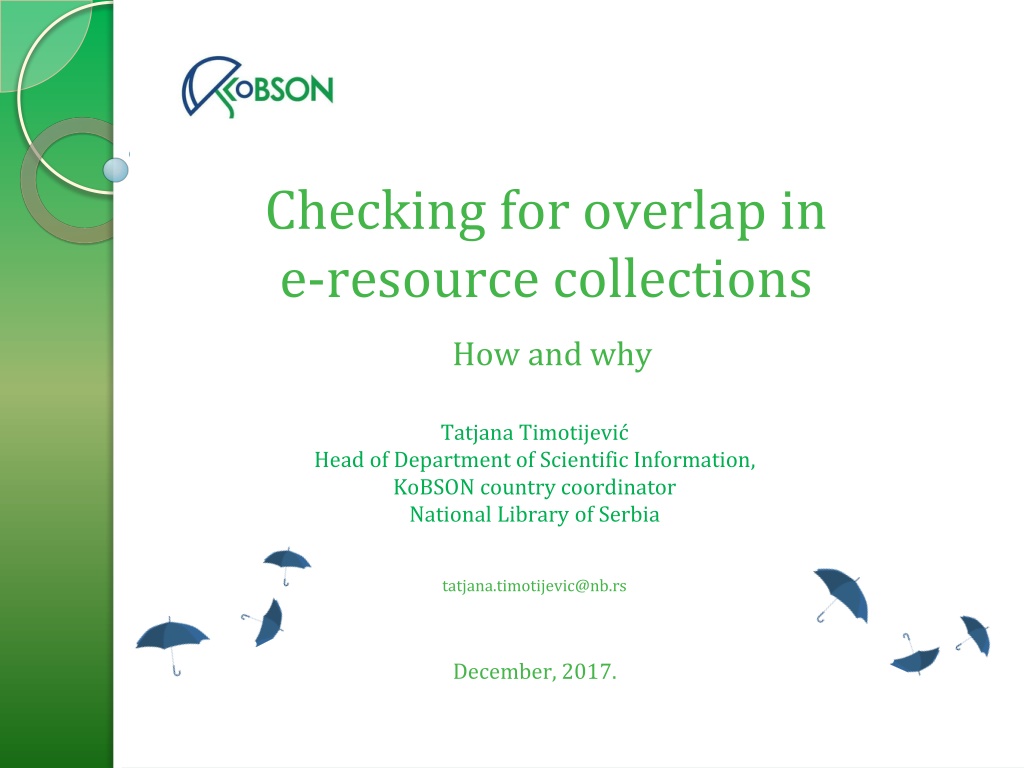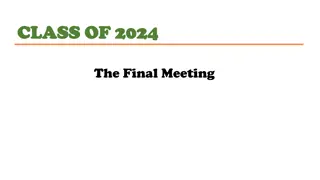Managing E-Resource Collections for Overlap Detection
Explore the process of checking for overlap in e-resource collections presented by Tatjana Timotijevic, Head of Department of Scientific Information at the National Library of Serbia. Discover how KoBSON's database facilitates the identification of content overlap in subscribed e-resources and learn about scenarios where overlap detection is crucial, such as evaluating new content offers and renewals. Gain insights into the structure of KoBSON's SQL server database, journal information, and the impact factor analysis conducted. Dive into the back-end details of the database, including journal title lists, publisher data, and impact factor categories.
Download Presentation

Please find below an Image/Link to download the presentation.
The content on the website is provided AS IS for your information and personal use only. It may not be sold, licensed, or shared on other websites without obtaining consent from the author. Download presentation by click this link. If you encounter any issues during the download, it is possible that the publisher has removed the file from their server.
E N D
Presentation Transcript
Checking for overlap in e-resource collections How and why Tatjana Timotijevi Head of Department of Scientific Information, KoBSON country coordinator National Library of Serbia tatjana.timotijevic@nb.rs December, 2017.
In this webinar Brief presentation of KoBSON s database of subscribed e-resource content, and how we can search it for content overlap Discussion of different scenarios of when we check for content overlap between e-resources collections: when considering new content, renewals, etc.
KobSONs database [Eleas - EleJour] The database was built in 2002 by KoBSON IT colleagues It is made on SQL server (currently 2014 version). It consists of a lot of related tables (for example 3 tables for E-journals, 3 for e- books and 3 for Impact Factor). We import Excel spreadsheets or Access table received from publishers (with their list of titles) into our SQL server. Then we make a query based on different needs and purposes.
KobSONs database [Eleas -EleJour] For every journal we have information whether that journal has Impact Factor (IF) or not, whether it is available through some of subscribed publishers/vendors or not. Let s take a look
Journal search on KoBSON webpage:
Journal search on KoBSON webpage:
What is in the back end? Journal title lists with detailed information (ISSN, abbreviated title, language, frequency ), data about its publisher, links, Impact Factor (IF) and JCR (Journal Citation Report) category
When do we check for overlap? Scenario 1: When we get an offer from a publisher for new content. For example: University of California Press Journals (23 titles)
We receive this kind of a list: Checking for overlapping is based on Journal ISSN not title (ISSN is unique, Title can be named differently: The Finite/Indefinite Article, Punctuation marks ) We make a query to find all journals from this list which are included in our current collections, through which service and whether they have IF.
These are the search results: From 23 journals, 9 titles have Impact factor (39.13%) which is high percentage, and shows great value of collections. But, from that number of journals, 15 titles are already available in our subscriptions through EBSCO, JSTOR, Hein Online, or in Open Access (DOAJ). Conclusion: the overlap is too high (65.22%).
All Journals 29.735 UCP UCP 23 All journals Overlapping 15 (65.22%)
When do we check for overlap? Scenario 2: if we have to cancel some subscriptions because of low usage statistics In the past, we had a subscription to eBrary e-books; from 84.430 books our users used only 7.654 titles. We decided to change the collection and subscribe EBSCO e-books instead. We checked overlap and received these results: Overlap 54.83% EBSCO had more titles, and more unique titles not included in eBrary (or other available collections)
When do we check for overlap? We do the same also when we must cancel some subscriptions because of lack of money. We had EBSCO and ProQuest Journals, we checked overlap. ProQuest had the higher overlap percentage, so and we cancelled that subscription. The majority of ProQuest Journals were already covered by EBSCO, HighWire, Free Medical Journals, Open Access
When do we check for overlap? It is of a great importance to have a valuable collection and to provide access to the most relevant literature, that s why we check for overlap with journal titles which have Impact Factor. That means that we provide our users access to the world s most influential literature.
When do we check for overlap? Scenario 3: When we prepare statistical data for our funders, the Ministry of Science. Criteria for making decision whether we will renew some subscription or not - for every service/publisher we present the following data: how many journals are available (for aggregators - how many unique journals), how many of them have IF, how many articles Serbian authors published with that publisher, how many downloads we had in a previous year, and the price per article
JSTOR All journals
Thank you for your attention Questions? Website: www.kobson.nb.rs E-mail: Tatjana.timotijevic@nb.rs
You can also follow us on: Facebook https://www.facebook.com/KoBSON- 298844590828/ Twitter https://twitter.com/kobson_twitty?lang=en























